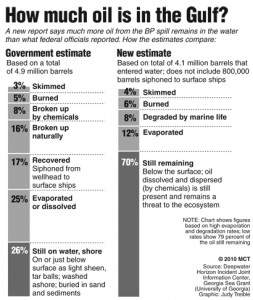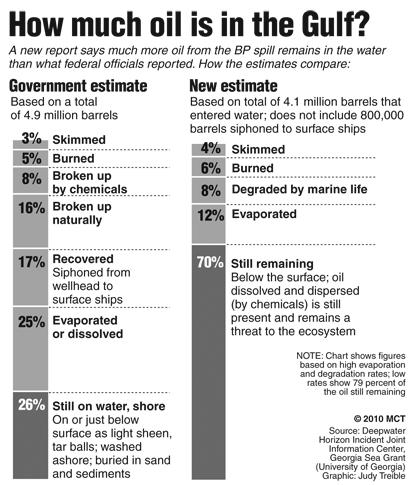 As facts about the BP oil spill begin to surface in the news media, one wonders if the truth will ever make it to the top, too. Recently, scientists found a large plume of oil underwater 40 miles away from where the Deepwater Horizon rig exploded back in April. The deepest known stretch of oil was 4,200 feet beneath the surface, very close to the ocean floor. True to form, this contradicts statements made by then BP chief executive Tony Hawyard about the buoyant nature of oil. His theory? Oil floats. So at some point, it’s got to come to the top. Not surprisingly, Hayward’s scientific wisdom ran counter to the findings of researchers working on the vessel Pelican, which discovered multiple plumes in the depths of the Gulf. Some of these stretched as many as 10 miles long.
As facts about the BP oil spill begin to surface in the news media, one wonders if the truth will ever make it to the top, too. Recently, scientists found a large plume of oil underwater 40 miles away from where the Deepwater Horizon rig exploded back in April. The deepest known stretch of oil was 4,200 feet beneath the surface, very close to the ocean floor. True to form, this contradicts statements made by then BP chief executive Tony Hawyard about the buoyant nature of oil. His theory? Oil floats. So at some point, it’s got to come to the top. Not surprisingly, Hayward’s scientific wisdom ran counter to the findings of researchers working on the vessel Pelican, which discovered multiple plumes in the depths of the Gulf. Some of these stretched as many as 10 miles long.
As long as there has been media, consumers have picked cautiously at the contents, sifting truth from bias and opinion. This is nothing new. What makes navigating these treacherous waters even harder is when the compass – i.e. the media – is being manhandled by its master – i.e. BP. Time and time again, BP has refused to deal squarely with the media, misleading the public in the process. From doctored photos to failed attempt after failed attempt to cap the well, BP’s credibility has sunk faster than an oil tanker with one hull.
In May, scientists estimated a possible 25-80,000 barrels of oil spilling daily from the well. They also requested that BP allow researchers to use more sophisticated equipment to allow them to see exactly how much oil is gushing from ocean floor. BP denied those requests, arguing that doing so would distract from the response effort. Meanwhile, the government calculated only 5,000 barrels were leaking each day.
Three months have passed and already the President is playing in the Gulf waters. He is munching on seafood at his birthday bash. While Obama may be comforted by the government’s claims that almost 75% of the oil is gone, the rest of us have our common sense telling us otherwise. Scientist Richard Camilli gave us concrete proof as he tested the oil. As the leading researcher on the underwater plume, he believes the government overestimated the rate of evaporation.
True enough, Americans from all regions (and the world) breathed a sigh of relief when BP finally stopped the flow. But now that plumes have been found below the surface, BP’s reliability comes into question once again. The owner of the rig, Transocean, is now accusing BP, the rig operator, of withholding information that is essential for furthering the investigation into the cause of the spill. BP has shot down at least seven of Transocean’s requests for information. When lawmakers came knocking, demanding answers from the British petrol giant about the spill before the U.S. Senate Committee on Energy and Natural Resources, mum was the word. Now we find that there is underwater oil, something BP assured us was impossible.
One thing is certain: while answers remain so far from shore, and so deep in BP’s pocket, the public might never really now what is going on underneath the surface. What we do know is that there is oil floating underneath the seas, and it doesn’t always come to the top. And it doesn’t even take a CEO to figure that out.







